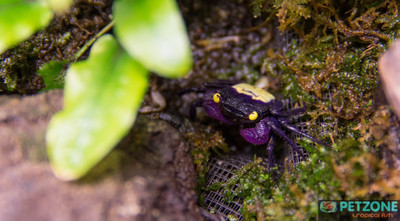The Enigmatic Purple Vampire Crab: A Fascinating Species of the Aquatic Realm
Posted by Max Gandara on on 6th Jun 2023
The Enigmatic Purple Vampire Crab: A Fascinating Species of the Aquatic Realm
Introduction:
The world of crustaceans is teeming with diversity, and among the many
remarkable species, the Purple Vampire Crab (Geosesarma sp.) stands out
as a captivating creature. This unique crab, known for its striking
purple coloration and intriguing behavior, has garnered considerable
attention from aquarium enthusiasts and researchers alike. In this
article, we delve into the world of the Purple Vampire Crab, exploring
its habitat, appearance, behavior, and care requirements.
Habitat and Distribution:
Native to the island of Java in Indonesia, the Purple Vampire Crab
inhabits the lush rainforests, specifically the leaf litter and wetland
areas. This species has also been introduced to other parts of the world
through the aquarium trade. They are semi-terrestrial, meaning they
spend time both in and out of the water, requiring a suitable
environment that includes both land and water areas.
Appearance:
What truly sets the Purple Vampire Crab apart is its stunning purple
coloration. The carapace and legs of this species exhibit various shades
of purple, ranging from deep violet to lavender. This coloration is a
result of natural pigments present in their exoskeleton, which play a
role in their communication and mating rituals. These crabs are
relatively small, with adult males measuring around 2 inches in size,
while females tend to be slightly larger.
Behavior:
The Purple Vampire Crab is known for its interesting behaviors, adding
to its allure. These crabs are primarily nocturnal, meaning they are
most active during the night. They are opportunistic omnivores, feeding
on a wide range of food sources, including decaying plant matter,
insects, small invertebrates, and even carrion. Their scavenging nature
contributes to the balance of their ecosystem.
In terms of defense and aggression, these crabs possess unique
adaptations. Males, in particular, exhibit highly territorial behavior
and may engage in battles to establish dominance. During these
encounters, they may use their specialized pincers to wrestle and
intimidate rivals. However, despite their intimidating name, Purple
Vampire Crabs do not possess any blood-sucking abilities or pose any
threat to humans.
Aquarium Care:
For those interested in keeping Purple Vampire Crabs in captivity, it is
essential to recreate their natural habitat as closely as possible. A
spacious tank with a combination of land and water areas should be
provided. The land portion can consist of damp substrate, such as
coconut fiber or peat moss, along with hiding spots like rocks,
driftwood, or plants. The water area should be shallow but large enough
for the crabs to swim and molt comfortably.
Maintaining appropriate humidity levels and temperature is crucial for
their well-being. The ideal temperature range is around 75-85°F
(24-29°C), while humidity levels should be maintained at 70-80%. Regular
misting and a water dish to provide freshwater should be included in
the setup.
Conclusion:
The Purple Vampire Crab, with its mesmerizing purple coloration and
intriguing behavior, continues to captivate both hobbyists and
researchers. As a unique and relatively small species, their care
requirements can be met in a well-maintained aquarium setup that mimics
their natural habitat. Responsible ownership and respect for their needs
will ensure the continued appreciation and preservation of this
fascinating crustacean.

